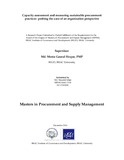| dc.contributor.advisor | Hoque, Md. Mosta Gausul | |
| dc.contributor.author | Islam, Md. Mazedul | |
| dc.date.accessioned | 2018-05-30T05:57:05Z | |
| dc.date.available | 2018-05-30T05:57:05Z | |
| dc.date.copyright | 2016 | |
| dc.date.issued | 2016-12 | |
| dc.identifier.other | ID 15182020 | |
| dc.identifier.uri | http://hdl.handle.net/10361/10222 | |
| dc.description | This dissertation is submitted in partial fulfillment of the requirements for the degree of Masters in Procurement and Supply Management, 2016. | en_US |
| dc.description | Cataloged from PDF version of dissertation. | |
| dc.description | Includes bibliographical references (page 66). | |
| dc.description.abstract | Measuring and reporting the effectiveness of sustainable procurement is a new challenge in the
field of purchasing. In many organizations the effects of sustainable purchasing have not been
determined or evaluated. The procurement effectiveness reporting tool will produce information
on the effects of procurement that can be then used in developing the sustainable purchasing
activities in an organization. This thesis gives the reader specifically for Hifab International AB
an example as a case study of an approach on how to measure and report strategic project based
sustainable procurement effectiveness through different variables. This practice will contain job
descriptions for all roles involved in procurement, instructions on how to handle effective
communication, purchasing ethics and policies and detailed descriptions of the sustainable
procurement process and its sub process.
The following objectives were determined: defining different methods of measuring sustainable
procurement effectiveness (1), creation of a procurement effectiveness reporting tool aligned
with the corporate and procurement strategies (2) and drawing sustainable development plans
for effectiveness reporting (3). The procurement effectiveness reporting tool focused on
developing effectiveness factors that can be evaluated by using an evaluation scale.
Due to specific demands in sustainable procurement in the private sector is vastly different
from its private counterpart. Public organizationsfor example have to meet higher standards
regarding transparency, integrity, accountability, and exemplary behavior(Telgen, Harland
&Knight, 2007) and have to abide to different rules and regulations than private organizations
when they are procuring goods and services. The notion that
publicprocurementisusedasapolicytooltoreachdesiredoutcomesinsociety also makes public procurement distinct from private purchasing. By implementing sustainable procurement the
Dutch government is therefore adding complexity to the alreadycomplexprocurementprocess.
Implementing sustainable procurement requires organizational routines to be changed
and the implementation of sustainable procurement should therefore be
viewedasanorganizationalchange.Thisresearchhasconsequentlyusedtheories and insights from
change management literature as a theoretical framework. Change management literature
suggests that when an organizational change is studied five different aspects should be
examined: process, content, context, leadership, and outcome issues (Kuiperset al., 2014). Based
on the literature from both sustainable
procurementandchangemanagementthemostprominentfactorsfor theimplementation of SPP
were identified for each aspect: change agents and procedural justice (process), red tape
(context), fit with vision (content), top management support and transformational leadership
(leadership), and commitmenttochange,sustainable
procurementbehavioranddegreeofsustainableprocurement(outcome).
The theoretical background was established by acquiring information from literature, previous
research and professional journals. The theory was used for applying ideas and methods to
develop the reporting tool. Internal interviews and workshops were used to scan the challenges
and issues with the current reporting tool. External interviews were used to find new ideas and
concepts that could be applied to the reporting. Through the conducted research, a procurement
effectiveness tool was created that fitted the needs of the commissioning organization. The tool
focused on evaluating the other effects of procurement and on creating a common alignment for
determining the cost savings produced. | en_US |
| dc.description.statementofresponsibility | Md. Mazedul Islam | |
| dc.format.extent | 70 pages | |
| dc.language.iso | en | en_US |
| dc.publisher | BRAC Univeristy | en_US |
| dc.rights | BRAC University dissertations are protected by copyright. They may be viewed from this source for any purpose, but reproduction or distribution in any format is prohibited without written permission. | |
| dc.subject | Capacity assessment | en_US |
| dc.subject | Procurement | en_US |
| dc.title | Capacity assessment and measuring sustainable procurement practices- probing the case of an organization perspective | en_US |
| dc.type | Dissertation | en_US |
| dc.contributor.department | BRAC Institute of Governance and Development, BRAC University | |
| dc.description.degree | M. Procurement and Supply Management | |

